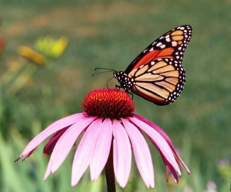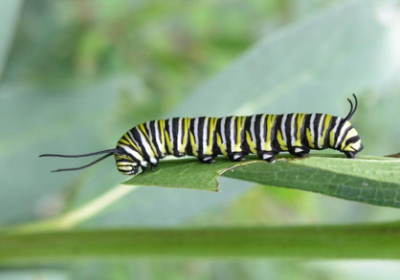By: Ana Legrand, Department of Plant Science and Landscape Architecture, 2015.

The monarch butterfly holds the record for the longest regularly repeated migration. A delicate butterfly that is able to travel between 1,200 and 2,980 miles to journey between three countries – Mexico, United States and Canada. But more on these amazing travels later. Monarchs (a.k.a Danaus plexippus for their scientific name) are bright orange butterflies with white dots on their black wing borders. They also have well-defined black veins on the wings. One can distinguish male from female butterflies by looking at the hindwings. Males have a dark spot on the hindwings while females do not.
This insect has been the inspiration of many stories and has become the symbol for many civic organizations. Its development is representative of an amazing transformation going from a single egg to a larval or caterpillar stage then to a pupa stage and finally to the adult butterfly form. Monarch caterpillars use milkweeds as their food plants. If their life cycle is intriguing then their manner of escaping harsh winter conditions is awe-inspiring. In late summer we may encounter these butterflies in what may appear a casual flight around our surroundings. However, they are engaged in a determined journey to some of the tallest mountain peaks in Mexico. In these mountains, monarchs find shelter in dense fir dominant forests. In Mexico, the fir forests are known as the ‘oyamel’ forests. Monarchs begin their voyage in summer breeding grounds in Canada and United States and fly south to avoid our harsh winters. We might take for granted our knowledge of the eastern monarch’s migration but it took a 38-year search by Frederick and Norah Urquhart to find out where the monarchs of eastern North America overwintered. The oyamel forests are found at elevations from about 9,800 to 11,000 feet above sea level on nine mountains west of Mexico City. There the butterflies form huge aggregations on oyamel firs and cypresses found also in the region. To make it through a journey of 2,980 miles, butterflies build up large quantities of body fat (yes, they too deal with that). Those that leave Canada with poor body fat reserves are less likely to reach Mexico. During their trip they stop to take nectar and in Texas and northern Mexico they really load up to make sure that their body fat reserves are good for their overwintering stay. The oyamel forests do not provide sufficient food for the millions of butterflies that assemble there.

Higher air temperatures and longer days during January and early February signal to the monarchs that it is time to leave their oyamel forests. Mating begins in January but it really peaks up during March. The butterflies that overwintered in the oyamel forests are known as the Methuselah generation because the adults survive 7-8 months. The offspring of these monarchs will not be so long-lived but survive around 4-5 weeks sufficient to leave new offspring as they keep on their journey northwards. Eventually, the great-great-great-grandchildren of the monarchs that traveled from Canada to Mexico are the ones that reach their northernmost breeding grounds during summer.
Unfortunately, these butterflies that have been able to survive such long journeys between Canada, United States and Mexico might not survive our encroachment on their habitat. Western populations of monarchs that overwinter in California face destruction of their overwintering sites as coastal land is developed. Eastern monarchs suffer increased mortality due to the loss of dense oyamel forests that provide critical microclimate protection. Other threats are loss of milkweeds for the caterpillars and impacts from climate change. In January 2015 the World Wildlife Fund in Mexico reported that the size of the 2014-2015 overwintering population was the second smallest since monitoring began in 1994. To learn more about the monarchs check out the following websites:
http://www.xerces.org/monarchs/
Papalotzin – documentary clip
https://www.youtube.com/watch?v=APyvV6S2p10
Monarch caterpillar feeding and pupating video
http://video.bugwood.org/browse/detail.cfm?vidnum=00000355